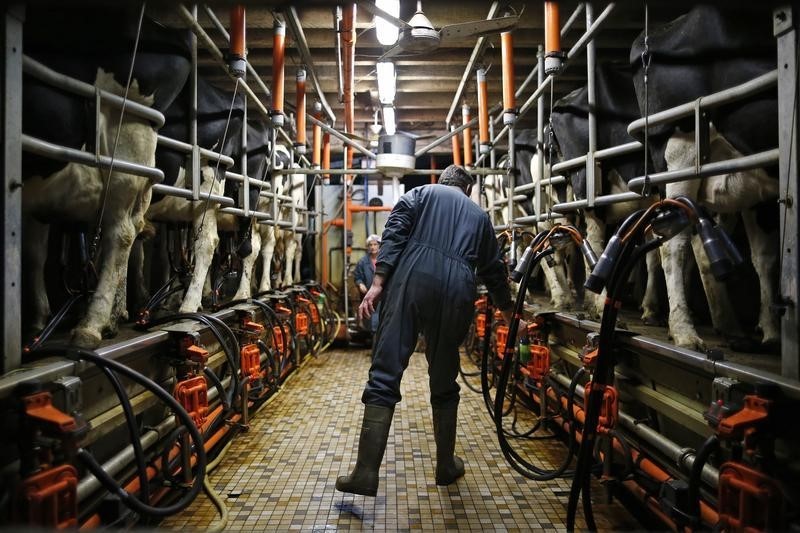By Allison Lampert, Krista Hughes and Rod Nickel
ACTON VALE, Quebec/WASHINGTON/WINNIPEG, Manitoba, Aug 9
(Reuters) - N ew Zealand dairy farmers have a message for their
Canadian counterparts, who worry that a Pacific trade deal will
throw them on the mercy of world markets and devastate their
industry: It's not so bad.
But heavily protected Canadian farmers have reason for
skepticism.
A deadlock over dairy has emerged as one of the chief
impediments to completing the 12-nation, $300 billion
Trans-Pacific Partnership, with Canada and Japan reluctant to
open protected markets, the United States unwilling to move
before Canada does, and New Zealand refusing to back down from
demands for more access to U.S., Japanese and Canadian markets.
Canada's ruling conservatives fear a backlash in October's
federal elections if they cut protections for dairy farmers, 80
per cent of whom live in vote-rich Quebec and Ontario, and allow
in more imports.
New Zealand's own dairy farmers have survived the removal of
government subsidies during the 1980s and 1990s that had once
made up a third of farm income.
The country's shift to an open market has meant that the
price of milk on supermarket shelves fluctuates with exchange
rates and world milk prices. But farmers note that New Zealand
still dominates a third of world trade in core dairy
commodities.
Andrew Kusabs, who has nearly 500 cows on two farms near
Rotorua on the North Island, said New Zealand farmers first had
to cope with losing their main export market, when the United
Kingdom joined the European common market in 1973, and then with
the dismantling of quotas.
"It was traumatic for some people but those that got their
act together very quickly, they survived," he said, noting that
Canadian farmers, who have an average herd size of 80 cows
compared to New Zealand's 413, might just have to change the way
they farm.
"You feel sorry for them, but the world moves on and you've
got to go with it."
Earl Rattray, a founding director of cooperative Fonterra
FCG.NZ , who has 250 cows in the North Island's Waikato region,
said deregulation "was one of those moments that made us wake up
and grow as an industry."
"Everyone said at the time, 'what a disaster, the sky is
falling in,' but if you stand back and look at it now after 30
years, our industry ... is nearly four times the size it was
then."
LIKE MCDONALD'S
New Zealand's size and huge market share are unnerving for
trading partners, however.
In New Zealand, where cows outnumber people, dairy is a
huge part of the economy, accounting for 7 percent of the
nation's gross domestic product and a third of export income -
mostly sold through Fonterra.
New Zealand's domestic market consumes only 5 percent of the
21.9 million metric tons of milk produced each year, leaving
farmers hungry for new export destinations.
In Canada, net dairy farm receipts of C$6.07 billion ($4.62
billion) are a drop in the bucket of the country's C$1.98
trillion economy.
Canada's supply management system for dairy, poultry and
eggs, in place since the 1970s, is designed to match production
to domestic consumption by allowing licensed farmers to produce
only a set amount of milk. Meanwhile, hefty tariffs - of as high
as 299 percent on butter, for example - discourage imports.
The controls have kept prices high. One liter of Canadian
milk cost on average C$2.49 ($1.90) in May, compared to $1.96
for a half gallon (1.9 liters) in the United States.
Quebec farmers Jacinthe Guilbert and Mario Vincent, whose
dairy herd consists of 80 cows, said scrapping supply management
would mean the end of family-run farms like theirs.
"It's the best system in the world because it allows family
businesses to live well," said Guilbert, who took on a C$2.5
million loan in 2010 to build a new barn.
Obtaining a bank loan was only possible because of supply
management, she said, because the system ensures stable prices
for milk.
Unlike New Zealand's free-roaming, grass-eating cows, herds
in the United States and Canada often live indoors. Canada's
milk production costs are nearly double those of New Zealand,
according to a Boston Consulting Group study.
"We see the quota system a bit like buying a franchise from
McDonald's (NYSE:MCD)," said Vincent. "It ensures that you won't have 10
McDonald's within a certain population. It makes sure you will
have a guaranteed market."
The United States, where average herd sizes top 1,000 in
some states and which ships almost half the dairy exports within
the TPP, is caught between offensive and defensive interests.
It wants to keep New Zealand on its side by allowing in more
products such as butter, which currently have tariffs as high as
$1.54 per kilogram (2.2 lbs.), but balance imports with
lucrative new export markets for U.S. milk, butter, cheese, whey
and yoghurt.
"Dairymen in the United States are open to the Trans-Pacific
Partnership and doing our part as long as we don't have to
shoulder the whole program," said Brian Hardy, who runs 2,000
cattle over 2,000 acres (809 hectares) in northern Utah, with
family members.
"It's really time that Canada stepped up to the plate and
opened its market."
($1 = 1.3123 Canadian dollars)
(Writing by Krista Hughes; Additional reporting by Gyles
Beckford in Wellington; Editing by David Chance and Sue Horton)
